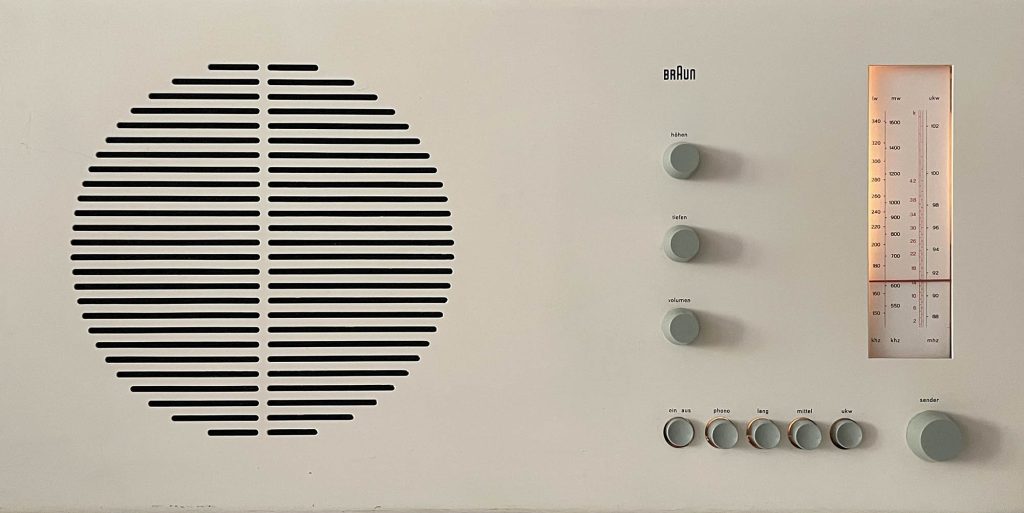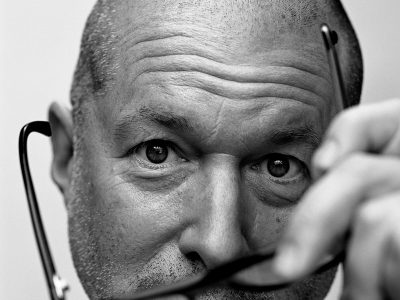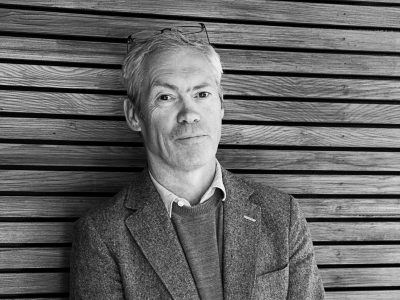
The front of the RT 20 refers to the layout of the SK4
Photo: Gerrit Terstiege
“Simplicity does not mean just making a box, but to create a harmony”
Interview with Naoto Fukasawa by Gerrit Terstiege
Gerrit Terstiege: Naoto, simplicity and minimalism are terms you and Dieter Rams are both associated with. Do you think that there is a typically German and a typically Japanese kind of simplicity?
Naoto Fukasawa : Yes. In my opinion, German simplicity is to make sure that a form does not go against mechanical engineering elements. In other words, it is a pure expression of „form follows function“. On the other hand, Japanese simplicity seems to find its simplicity in the fact that it is composed of as few elements as possible, as expressed in the term „light, thin, short, and small,“ which means that the object itself will eventually disappear, leaving only its function. As an analogy, in Germany, when designing a door handle, it is to make it firm, easy to grip, massive, and unbreakable, whereas in Japan there is a tendency toward how to eliminate door and other handles while making them functional. Simplicity in the German sense is expressed in form, but in Japan, simplicity seems to exist as an idea before it is expressed in form.
GT: Do you think simplicity (as a phenomenon or attribute) is changing with the zeitgeist, or does it basically stay the same?
NF: I think it will change. Personally, I believe that the ultimate simplicity will be reached when everything blends with minimalism and harmonizes with the environment, leaving only functionality and becoming part of nature.
GT: When was the first time you heard or read about Dieter Rams?
NF: It was in the university. I knew the name Braun which at the time in the early 1980’s, in my mind at least, was synonymous with that of Dieter Rams. And vice versa.
GT: Which Braun products were available in Japan at that time?
NF: I think only the shavers, a few of the hair dryers maybe. I joined a product design course in my university. In my memory, the teachers did not have a broad know-how about design, but they used Braun products as examples for us to understand good design and to explain to us how important a design philosophy can be, how important details can be. However other teachers at the art center showed us very fancy car designs. We as students were a bit confused, between the minimalistic and the fancy design.
GT: So you had to decide which side you wanted to be on?
NF: No, both ways interested me. I did not feel I had to decide as a student. At the time I did not just follow one way or another, I tried to understand: what is design?
GT: But after a while I saw how difficult it is to make simple things that involve technology. So after my graduation I learned from Dieter or from Braun what it means to have for example a no draft angle on a case of a technical product. How difficult it is to realise and how expensive it is to make a tool with a no draft angle.
NF: Dieter for me is the hero of the no draft box. It is so hard to communicate the aesthetic relevance of a right angle to technicians who always want to make production easy and to go for the cheapest way. Almost all engineers said to me: „it’s impossible“ and then I could say: „but Braun does it“. I think Dieter has done 90 degree angles very early on with moldings.
GT: What would you say in general was appealing to you with Braun products and Rams designs?
NF: Their honesty and integrity. They are to me not at all cool, but friendly.
GT: Yet lot of people think of Braun products as technical, very manly products. Would you agree?
NF: No, I don’t think so. They are very warm.
GT: Perhaps this aspect is oftentimes overlooked when products are known only as photographs. Depending on the angle or the photographic style, Rams designs can appear very austere. And especially when we talk about the products of the fifties and sixties, most people only know them from photos in design books, magazines, on websites or on Instagram. But when you actually live with a radio and use it every day, you realise its character – the way it feels, the way it sounds, the warm light of its scale …
NF: True. I feel the same. Just think of the turning knops of the T 52 radio – they are just a little bit slanted, they have a subtle angle to they can be more easily steered with the finger-tips. A purely minimalistic approach would have been to simply use the shape of a cylinder. But Dieter chose this angle to make it more user-friendly. An amazing choice. And Professor Klemp once gave me a Nizo camera as a present, that is wonderful, too. And Dieter gave me the Braun calculator that has influenced the iPhone application. That was a wonderful story.

Historical meeting: In 2012, Naoto Fukasawa visited Dieter Rams in his home in Kronberg
© Studio Fukasawa
GT: Yes, when this went viral on the internet, it profoundly changed how he was perceived, especially internationally because the iPhone of course was sold and is still sold in the millions. What would you say have you learned from Dieter Rams?
NF: I learned from him an attitude of believing in good design. An attitude that has never changed. That good design leads to a better life. That is his philosophy.
GT: Maybe one might call this stubborn. But he has a very strong attitude. And it is important for a designer to stay true to his or her convictions. Many people think of Dieter Rams today as an„author designer“ with his own typical design language—but of course he was for over four decades with Braun and strongly set guidelines for himself and his team. What model in your opinion means more freedom for a designer: working as a staff designer of a single company or working as a free „author designer“ like you today, active for different companies?
NF: Having my own design studio and collaborating with different kinds of companies, as I do, inevitably means designing different kinds of things. In that respect, I think my position is more flexible. However, I never think Dieter had less freedom as a designer. He has drastically changed product design up to now by sharing concise mottos with himself and his team, such as 10 principles for good design. Not in an exaggarated way, but quietly and essentially. The concise yet strong guidelines allowed him to be free from preconceived ideas. As a result, I believe he was able to design such a body of work. I have also established philosophies, rules, and concepts for my design approach with my team members, and we share them to maintain qualitative consistency in our various types of products. It is clearly a method learned from Dieter to pursue beauty and essence freely and without preconceived ideas. This attitude has not changed since I became independent 20 years ago. But when I had just become a designer, in the early 80s, another movement was taking place: post-modernism. Then came a time when the kind of emotional design by Hartmut Esslinger, who directed Frog Design, made Dieter’s principles seem old-fashioned.
GT: „Form follows fun“ was the slogan Esslinger was promoting back then.
NF: Yes, right. And then a more organic, emotional design became stronger with Philippe Starck. So maybe for 20 years, from the early 1980’s to the early 2000’s, Dieter Rams‘ work almost disappeared in the eyes of many. But in this period he still trusted his way and quietly kept working. Starck as an influence was disappearing and Jasper Morrison was coming up. And with Jasper, Dieter had a great come-back and became a hero again, with a very strong impact. So stubborn and so focused on what is right and what is wrong. So that made a big difference: to keep on doing the right things, the things he believes in. Of course the economy changes and therefore we have to change the form and the functions. But in my eyes, minimalism has more soul and is a more philosophical expression. More like a way of thinking. Simplicity does not mean just making a box, but to create a harmony. For people and for the environment.
GT: So is a Rams product like the RT 20 radio on your desk still fitting in our lives?
NF: I think it is.
GT: What is a Rams design that stands out for you?
NF: Definitely the TP 2, the radio combined with the small record player for 45’s. That is maybe his best design, in my opinion. For example, the brown colour of the leather strap to carry it is very appealing. An unusual choice of both colour and material. It was very innovative to use leather for a technical plastic object. That made a big impression on me. Who would come up with something like that? Noone at the time. Also the light wood used at the RT 20 radio—this is not cool, but warm and friendly.
GT: Since you mentioned the brown leather strap, let’s talk a little bit about the subtle colours and colour combinations of Rams designs. The light grey of some of his early radios have influenced you I think. And they seem appealing to you still. Is that correct?
NF: Yes, a colour can make a very strong stimulus. A bright yellow or red or blue. But too many colours together can create quite a mess—and look not very sophisticated. But a neutral grey that Rams used, or a warm grey can become a beautiful background or a platform for a colour. That’s why I love using grey. Both cool and warm grey. Almost like him: he is sometimes playing „the cool guy“, but actually is so nice. (laughs)
GT: Is this something you noticed when you met him personally? In 2012 you visited him in Kronberg.
NF: Yes, that was a great moment in my life. Unforgettable. Because he is my mentor. But when he invited me into his house, that’s when I became a real designer, in his point of view. He gave me a tour around the house and showed me all the rooms. Very generous. He particularly seemed to enjoy the workshop downstairs, with all the different tools hanging from the walls. That is his very own secret world. He was very proud to show me all that and I was of course impressed. I remember on one of his desks lay a milling panel, a raw piece of material of the MacBook Pro signed by Jonathan Ive, that Jony gave Dieter. It seemed to me like a tiny technical sculpture. But I feel the best place in his house is his Vitsœ working desk with the „Wandanlage“ audio system on the left and the desk with a black mat for drawing, he still uses pencils and quite a small stool for him to sit on—that perfectly sums up his life. I have met a few truely great designers and architects. Ettore Sottsass. Alvaro Siza Vieira. Antonio Citterio. Achille Castiglioni. All those big guys. But Dieter Rams is more theoretical, he has more rules. He created a guideline with his ten principles of design.
GT: And not to forget: he chose products you designed to go around the world in a traveling exhibition …
NF: Yes. Dieter chose Jasper Morrison, Jony Ive, and myself as three trusted designers to exhibit our work alongside his. It was a great honor. The exhibition was held at the Fuchu Art Museum in Tokyo in 2009, and was titled „Pure Forms: The Era of Dieter Rams – Reconsideration of Functionalist Design“.
GT: Let’s come to a recent product of yours: How did you develop the idea for your new “Asari” chair for Herman Miller?
NF: In every single type of product that exists, I believe that the best and most simple things are always those that already exist somewhere in the world. Dieter’s design is clearly an example for this. As for Asari chair, I believe it is more unique than simple.
However, I believe that being unique and being simple are not contradictory, and that the concept of simplicity exists even in things that appear unique. That is why you described the Asari chair as simple. Whether it is simple or not depends on how purely and uncompromisingly the original idea is embodied and achieved. The elements of iconicity and purity are inherent in simplicity. For example, simplicity can be seen in the design of a William Morris-book with its organic plant motifs, and of course simplicity is present in Swiss typography.
GT: One last question regarding The Design Science Foundation that you founded. What is its goal? Its name reminds me of the era of the HfG Ulm when design was more rational and the result of a scientific process rather than an artistic one.
NF: The major trigger was undoubtedly the fact that my design philosophy and way of thinking had already been unraveled by Ecological Psychology. Ecology is also a science that helps elucidate the relationship that exists between the environment and humans, which is similar to what design aims to do, so I thought that by treating design as a science, I could clarify the inspiration and emergence that had been a kind of black box. You mentioned that it reminded you of Hochschule für Gestaltung Ulm, and that is exactly right. I believe that even human emotions can be scientifically clarified as a function of the body.
More Contributions

Jonathan Ive
Numerous international designers have expressed how much Dieter Rams‘ work means to them. But the impact of what Jonathan Ive did through words and actions for the Braun design revival of the Rams era was and is immense and ensures a worldwide response — to this day. Time for an interview with the long-time Apple design chief.

Fabio De'Longhi
In 2012, the family-run De’Longhi Group took over the Braun Household division. In our interview, Fabio De’Longhi talks about how he sees Dieter Rams‘ legacy and what he expects from the future in terms of design, production methods and management strategies.
